Biofilm disruption with rubber cup polishing
Understand oral biofilm and rubber cup polishing to identify and treat the patients who can benefit most.
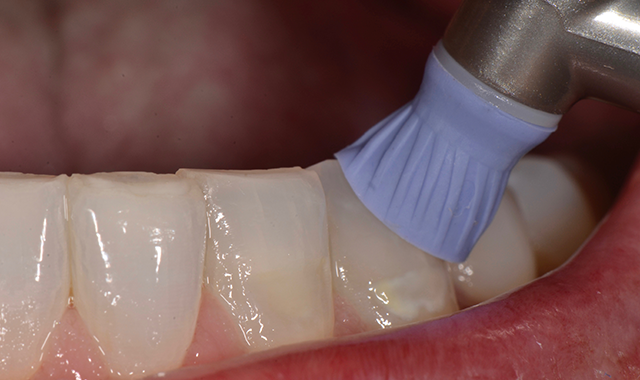
Our patients deal with biofilm throughout their lives. As dental professionals, we can help them better manage it by offering rubber cup polishing with disposable prophy angles in cases where it’s deemed appropriate.
Selective polishing, performed at the clinician’s discretion, can help control biofilm growth and prevent oral and systemic disease progression in our patients. Finding the right prophy angles and knowing the proper techniques for successful rubber cup polishing are key to patients realizing these benefits. Providing proper patient education also will help ensure patients know how rubber cup polishing can control biofilm and prevent disease as well as what steps they can take at home, including brushing and flossing regularly, to maintain a healthy mouth and smile.
Understanding biofilm
Bacteria colonization within the oral cavity (and throughout the rest of the body) starts at birth and constantly changes as patients age.1 At first, single planktonic cells develop throughout the cavity. This creates an ecosystem for bacteria (primarily Streptococci) to begin to form on tooth surfaces, leading to the first stages of biofilm.2
So, what exactly is biofilm? Basically, it’s a generic community of colonized cells on a surface. For our purposes, it’s important to note dental biofilm has all of the characteristics of biofilm architecture and microbial community interaction, but it develops in the oral cavity, consists of more than 700 contributing oral microbial species, and demonstrates a distinct method of conditioning the tooth surface.4-7
More from the author: How to improve patients' oral health in one step
Dental plaque biofilm is made of highly specialized, coordinated multispecies forms of microorganism life located permanently on the tooth surface in a matrix. A layer of extracellular polysaccharides surrounds these microorganisms to ensure they’re more resistant to immunological defense systems and less susceptible to antimicrobials, which can make them challenging to manage.5-7
A closer look at biofilm growth and development
The Ultrapro Tx Air handpiece
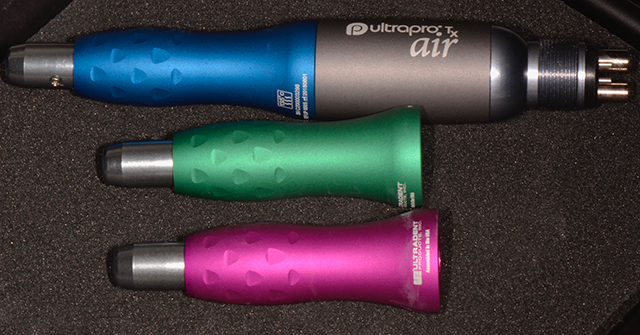
Beneficial and pathogenic bacteria live together in the human body, making balance-better known as microbial homeostasis-key to maintaining health in all systems. Microbial homeostasis balances both synergistic and antagonistic microbial interactions to bring stability to the oral cavity.8 When there’s homeostasis breakdown in the microbiome, it can lead to changes in the microflora balance-and that microbiological imbalance in the biofilm can predispose sites to disease, which is exactly what your patients want to avoid.8-11
Processes of decreasing and increasing biofilm pH occur before tooth surface de- and remineralization.1 When the mouth is healthy, these processes take place without causing tooth enamel damage, while the required balance remains intact.1 This means oral health maintenance is achieved when biofilm is disrupted regularly.
The benefits of rubber cup polishing
While important, maintaining basic oral hygiene habits, such as routine brushing, flossing and using antimicrobial rinses, isn’t the only way patients can combat the harmful biofilm that develops over time in their mouths. Rubber cup polishing can disrupt, destroy and control biofilm and is typically used in initial or supportive periodontal therapy, which effectively removes supragingival biofilm plaque.12
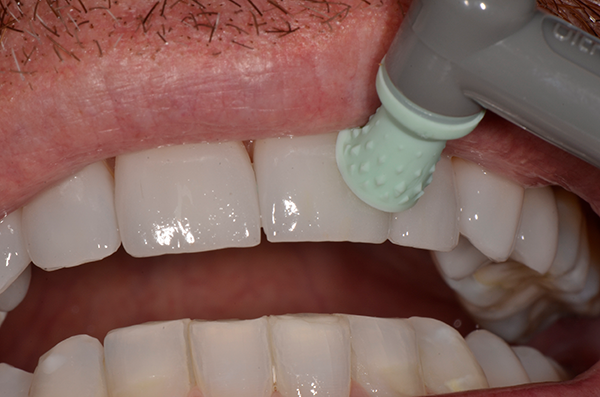
A patient having a prophy with the Ultrapro Tx Extra soft prophy angle.
There was a time when dentists used rubber cup polishing on every patient they treated. That’s because they thought it helped with fluoride uptake, which of course has its benefits. This is no longer a common practice because studies have shown there’s no evidence to support this theory.13 Today, rather than turning to rubber cup prophylaxis for every patient, dentists use selective polishing instead. Dentists only opt to complete rubber cup polishing when it’s deemed an appropriate way to control, disrupt, or destroy dental plaque biofilm, maximizing its effectiveness.
Research has shown polishing can lead to enamel mineral loss and should be limited to areas where stains can’t be removed by other methods.13 Clinicians must be able to determine when rubber cup polishing is necessary for biofilm removal to avoid the morphological changes that can occur in tooth structure with continuous polishing.13 This determination can be made after a comprehensive exam is completed.
Continue to page two to read more...
Why the prophy angle you use matters
When working to disrupt biofilm through selective polishing, a high-quality prophy angle is key to success. Disposable prophy angles are a great option because they help prevent cross-contamination.12
What exactly should you look for in a prophy angle? Here are a few of the main characteristics your prophy angles should have:
- A straight or contra-angle shape
- Firm and soft cups made from soft, latex-free material
- Internal and external fluting
- Splatter reduction to keep messes to a minimum
- The ability to flex and flare for reliability and optimal performance
Choosing the right prophy angle for your practice
There are a variety of disposable prophy angle options on the market today, including the Ultrapro® Tx prophylaxis family from Ultradent Products. This product line includes advanced prophy angle cup designs, splatter-free pastes and an ergonomic handpiece.
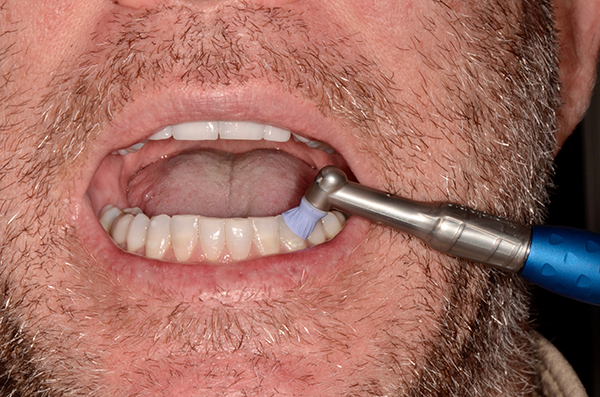
A close-up of the skini with 25 percent slimmer neck and shorter head.
The disposable prophy angles are comfortable to use and feature an ergonomic design, which is of course important for dental professionals who use these products every day. They also come equipped with smooth, quiet gears. These characteristics make the procedure more pleasant for both you and your patients. The Ultradent prophy angles are available in various options, including original, extra and skini.
Trending article: When the 'patient is always right' policy goes wrong
The cup design reduces splatter and allows for more efficient cleaning, which can save time. The angles feature optimal flare for improved subgingival access, enabling them to reach areas of the tooth other angles can’t. The extra and skini angles feature outer ridges for improved interproximal cleaning and are available in right-angle or contra-angle designs. With 20 percent shorter heads, all the prophy angles in this line are designed for improved access and visibility in the oral cavity. The skini angles also have a 25 percent slimmer neck and are sterile to minimize the risk of infection. There’s no natural rubber latex in any of these prophy angles, which are all available in soft or firm cup designs. Color-coded cups make it easy to identify firm or soft prophy angles (the green angles are soft and the blue angles are firm).
These prophy angle are value priced, and because they never expire, they can be bought in bulk for additional savings.
This line also includes a lightweight handpiece that allows for a smooth polishing experience. At only 2.2 ounces, the handpiece reduces hand and arm fatigue that often comes with rubber cup polishing. It features a 360° swivel for easy rotation and a soft-start motor to minimize splatter. The vibration-free handpiece cleans at a maximum speed of 4,000 RPM and features a universal E-type motor for multifunctionality. Beyond the angles in the Ultrapro Tx product line, it’s compatible with nearly all disposable prophy angles on the market today. The prophy angles also can be used with any handpiece.
While there are other prophy angles and handpieces on the market that you may want to consider, the Ultradent line offers an economical, reliable solution that effectively disrupts biofilm to help prevent disease in your patients. The ergonomic design also minimizes the risk of injury that comes with the repetitive motion rubber cup polishing requires.
What to look for in prophy paste
In the past, clinicians would apply pumice to stains during rubber cup polishing.13 Pumice is harsh, and research now shows less abrasive materials are better suited for this procedure. These materials give oral health professionals the ability to effectively remove stains while still maintaining adequate enamel.
There are a variety of pastes to choose from for rubber cup polishing, including the prophy pastes that are part of Ultradent’s Ultrapro Tx line. These gluten-free pastes are splatter free for easy cleanup. They contain 5% potassium nitrate, 1.23% fluoride ion, and are available in flavors your patients will love (Cool Mint, Walterberry®, Bubble Gum and Orange Dreamsicle). The pastes are also easy to rinse, eliminating the residual grittiness patients often associate with prophy pastes-leading to a more pleasant experience.
Continue to page three to read more...
The rubber cup polishing technique
While investing in the right prophy angles, pastes and handpiece is important for successful rubber cup polishing, you also need to know and use the proper technique for optimal results. To start, dental health professionals must put on personal protective equipment before beginning the procedure and provide patients with safety glasses.
Clinicians shouldn’t use rubber cup polishing to disrupt biofilm until they’ve deemed it appropriate for the patient in the chair.14 This decision should come after a comprehensive assessment. Once that’s complete and it’s time to move forward, the patient should be given a pre-procedural antimicrobial mouth rinse.
Once ready to go, dental health professionals should begin polishing at the distal surface of the most posterior tooth, then move toward the anterior, working on the gingival third to the incisal third of the tooth. The rubber cup should be filled with the right amount of paste for the tooth surface being polished. Pressure from the revolving cup must be light (just what’s necessary to remove biofilm and any stain on the teeth) and applied to the tooth surface using a low speed.
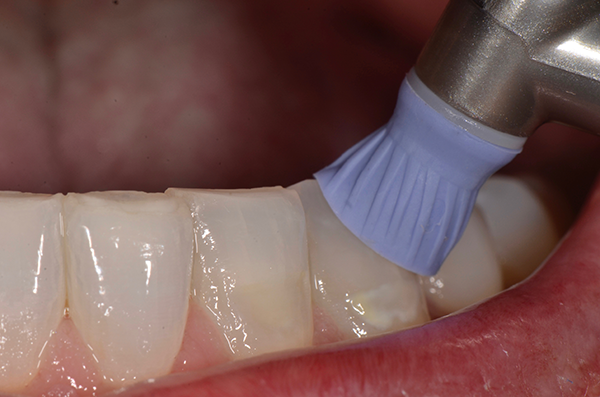
A close-up of the Ultrapro Tx tapered brush being used for sealant preparation.
The cup should flare slightly and slip into the sulcus. With an intermittent patting motion, the cup can be moved to an adjacent area of the tooth surface. The handpiece can be altered as needed by turning or lifting it. This will help the rubber cup adapt to the tooth surface.
Following these simple steps will help ensure you correctly perform the rubber cup polishing procedure, leading to optimal results for your patients (and a more pleasant, comfortable experience for you as well).
More from the author: The career-ending injury no one talks about
Educate your patients
Before beginning the polishing procedure, talk with patients about what you’re doing and why. Educate them about biofilm and the damage it can do to their teeth and their overall health. Explain what rubber cup polishing is and how it can benefit their oral health, including controlling biofilm and preventing disease.
This is also a great time to talk with patients about preventative maintenance they can do at home. Remind them how important it is to brush and flush regularly and to come to your office for regular checkups. Make sure they understand the damage biofilm can do to their teeth if it’s not taken care of. Show them proper brushing and flossing techniques if necessary, and let them know you’re happy to answer any questions they may have.
Conclusion
Throughout the course of our lives, complex biofilm communities grow and change in our bodies. As dental professionals, we’re most concerned with microbiomes or dental plaque biofilm communities that develop in the oral cavity and create a network of microorganisms that communicate as well as deliver nutrients and remove waste throughout the structure.
If this dental plaque biofilm is allowed to grow freely, it leads to disease and infection in our patients. While we’ll never be able to completely eliminate biofilm growth and development, there are a number of steps we can take to manage it. The first is promoting basic oral hygiene. We must educate our patients to properly brush and floss their teeth and to use antimicrobial mouth rinses at home. Engaging in proper home care not only disrupts bacteria growth, but in some cases it also inhibits it, leading to better outcomes for your patients.
Routine dental checkups are also key to maintaining optimal oral health. During these appointments, dental professionals can determine if rubber cup polishing is appropriate. When used on patients who need it, rubber cup polishing helps disrupt biofilm growth and control its development. Using disposable prophy angles for this procedure eliminates the risk of cross-contamination while keeping biofilm growth in check.
For the best results, it’s important for dental professionals to know what to look for in an effective, reliable and affordable prophy angle. Options like the Ultrapro Tx prophylaxis family from Ultradent Products give us the solutions we need to manage biofilm in our patients. Learning the proper rubber cup polishing technique is also key, helping to ensure we provide our patients with the best care possible.
References
1. Struzycka I. The oral microbiome in dental caries. Pol J Microbiol. 2014;63(2):127-35.
2. Kalesinskas P, Kacergius T, Ambrozaitis A, et al. Reducing dental plaque formation and caries development. A review of current methods and implications for novel pharmaceuticals. Stomatologija. 2014;16(2):44-52.
3. Listgarten MA. Formation of dental plaque and other oral biofilms. In: Newman HN, Wilson M (eds): Dental Plaque Revisited: oral biofilms in Health and Disease. Wales, Cardiff University, Bioline Publications, pp 187-210, 1999.
4. Aas JA, Paster BJ, Stokes LN, et al. Defining the normal bacterial flora of the oral cavity. J Clin Microbiol 2005;43(11):5721-32.
5. Davies D. Understanding biofilm resistance to antibacterial agents. Nat Rev Drug Discov. 2003;2(2):114-22.
6. Dufour D, Lévesque CM. Bacterial behaviors associated with the quorum-sensing peptide pheromone (‘alarmone’) in streptococci. Future Microbiol. 2013;8(5):593-605.
7. Stoodley P, Sauer K, Davies DG, et al. Biofilms as complex differentiated communities. Annu Rev Microbiol. 2002;56:187-209.
8. Marsh PD. Microbial ecology of dental plaque and its significance in health and disease. Adv Dent Res. 1994;8(2):263-71.
9. Høiby N, Ciofu O, Johansen HK, et al. The clinical impact of bacterial biofilms. Int J Oral Sci. 2011;3(2):55-65.
10. Hojo K, Nagaoka S, Ohshima T, et al. Bacterial interactions in dental biofilm development. J Dent Res. 2009;88(11):982-90.
11. Marsh PD. Contemporary perspective on plaque control. Br Dent J. 2012;212(12):601-6.
12. Petersilka GH, Ehmke B, Flemmig TF. Antimicrobial effects of mechanical debridement. Periodontol 2000. 2002;28:56-71.
13. Ripa LW. Need for prior toothcleaning when performing a professional topical fluoride application: review and recommendations for change. J Am Dent Assoc. 1984;109(2):281-5.
14. Madan C, Bains R, Bains VK. Tooth polishing: Relevance in present day periodontal practice. J Indian Soc Periodontol. 2009;13(1):58-9.
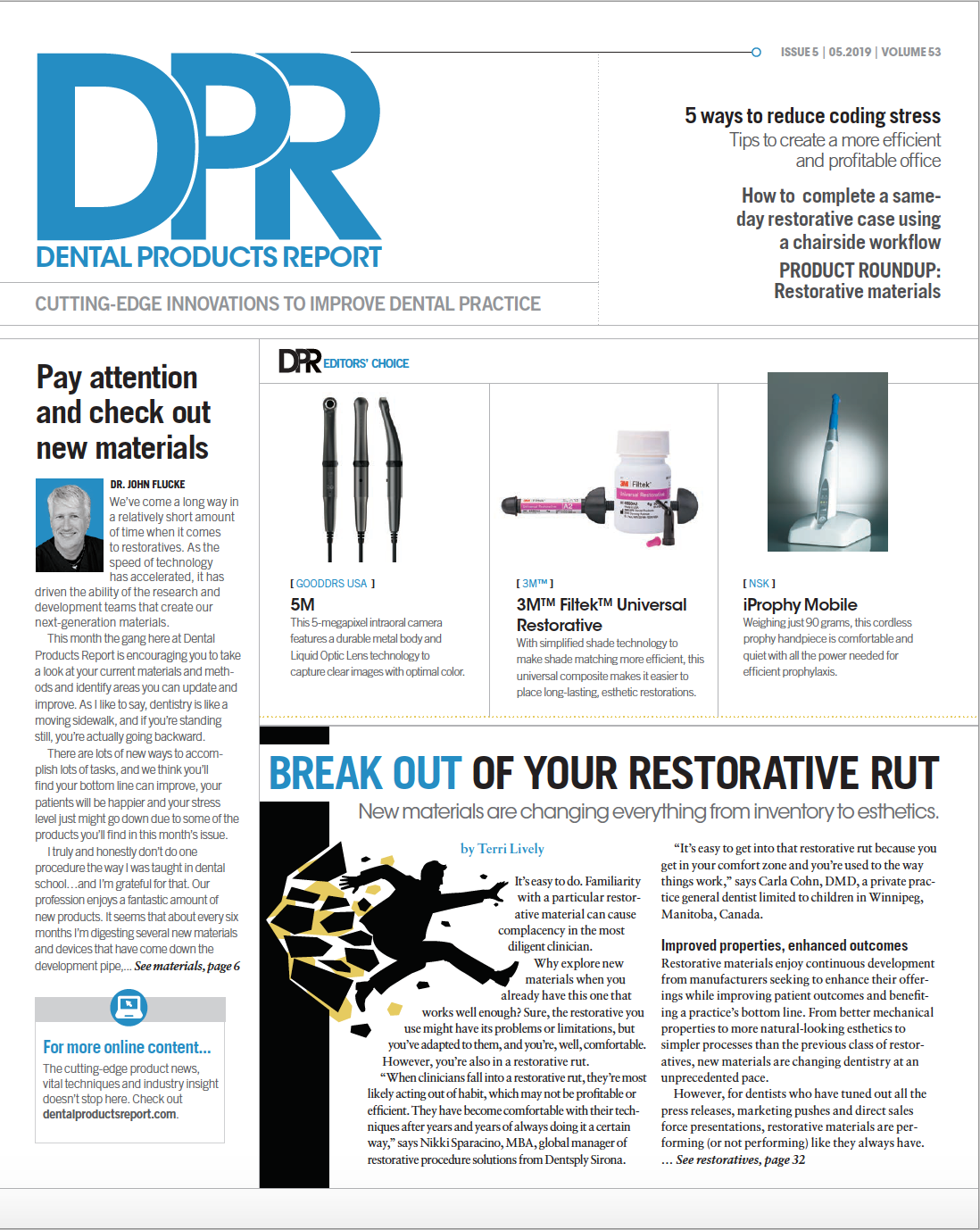
Floss & Flip Flops Episode 22: National Dental Hygiene Month
October 1st 2023Join the Sanders Sisters and Dr Anna Kay Thompson as they learn about the burning questions the medical community is not asking about oral health. Learn about all of the ways they are celebrating the good work of dental hygienists in their quest for whole-body health.
Maximizing Value: The Hidden Benefits of Preventing Hospital-Acquired Pneumonia Through Oral Hygiene
September 10th 2024Originally posted on Infection Control Today. Hospital-acquired pneumonia (HAP) is a significant infection prevention concern, leading to high patient mortality, increased health care costs, and ICU usage. Oral hygiene is an effective preventive measure.